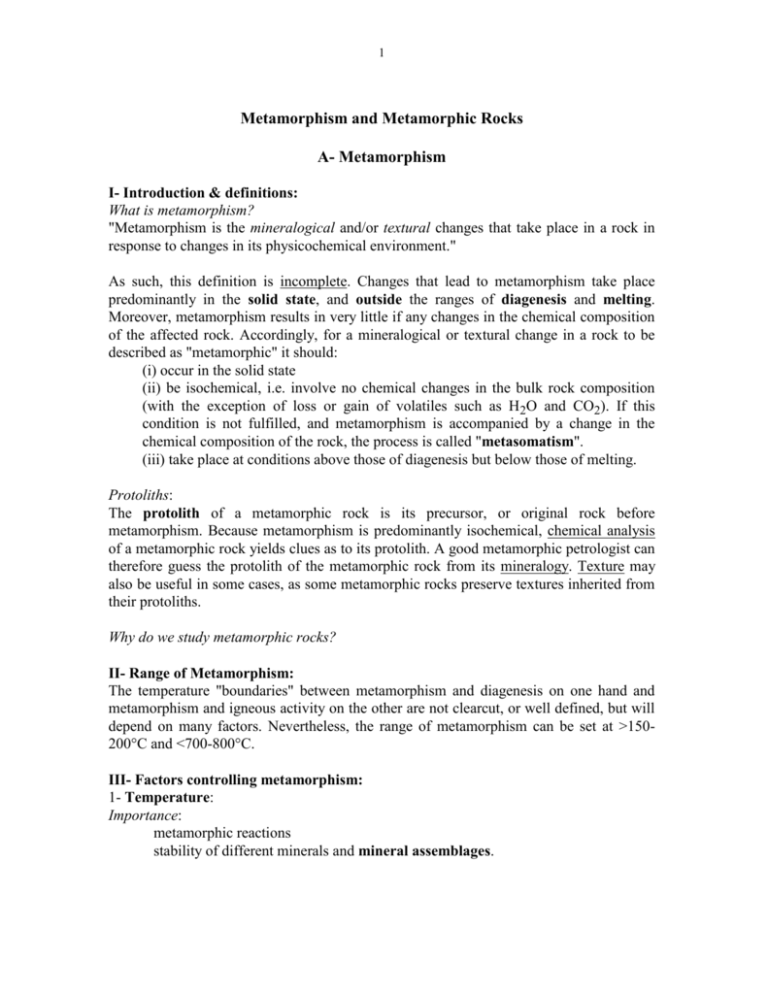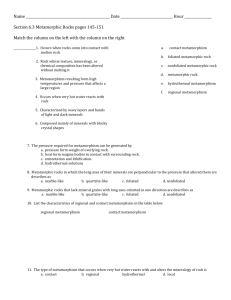Metamorphism & Metamorphic Rocks
advertisement

1 Metamorphism and Metamorphic Rocks A- Metamorphism I- Introduction & definitions: What is metamorphism? "Metamorphism is the mineralogical and/or textural changes that take place in a rock in response to changes in its physicochemical environment." As such, this definition is incomplete. Changes that lead to metamorphism take place predominantly in the solid state, and outside the ranges of diagenesis and melting. Moreover, metamorphism results in very little if any changes in the chemical composition of the affected rock. Accordingly, for a mineralogical or textural change in a rock to be described as "metamorphic" it should: (i) occur in the solid state (ii) be isochemical, i.e. involve no chemical changes in the bulk rock composition (with the exception of loss or gain of volatiles such as H2O and CO2). If this condition is not fulfilled, and metamorphism is accompanied by a change in the chemical composition of the rock, the process is called "metasomatism". (iii) take place at conditions above those of diagenesis but below those of melting. Protoliths: The protolith of a metamorphic rock is its precursor, or original rock before metamorphism. Because metamorphism is predominantly isochemical, chemical analysis of a metamorphic rock yields clues as to its protolith. A good metamorphic petrologist can therefore guess the protolith of the metamorphic rock from its mineralogy. Texture may also be useful in some cases, as some metamorphic rocks preserve textures inherited from their protoliths. Why do we study metamorphic rocks? II- Range of Metamorphism: The temperature "boundaries" between metamorphism and diagenesis on one hand and metamorphism and igneous activity on the other are not clearcut, or well defined, but will depend on many factors. Nevertheless, the range of metamorphism can be set at >150200°C and <700-800°C. III- Factors controlling metamorphism: 1- Temperature: Importance: metamorphic reactions stability of different minerals and mineral assemblages. 2 Temperature and depth of burial: geotherm & geothermal gradients types of geotherms (Fig. 1) Sources of heat: (i) the mantle, (ii) radioactive decay in the crust (iii) igneous intrusion. 2- Pressure: Types: Lithostatic Directed Importance: 3- Time: 4- Original chemical composition of the rock: Types of protoliths "Best" compositions or rock types for studying metamorphism 5- Composition of the fluid attending metamorphism: IV- Types of Metamorphism 1- Contact (thermal) metamorphism: 2- Cataclastic (dynamic): 3- Regional (dynamothermal) metamorphism: 4- Burial metamorphism: 5- Ocean floor metamorphism: 6- Impact metamorphism: Related to meteoritic impacts. Very high P and T, lasting for a short period of time. Summary of main Types of Metamorphism Type Cataclastic Contact Main factors mostly P T ± fluids Regional Textures cataclastic Hornfelsic granoblastic usually foliated Burial Non foliated, relict P and T Ocean floor Variable; non- T, fluids ± P foliated, foliated and relict Shock textures; P and T tektites Impact P, T ± fluids P-T conditions med P, low T High T, variable P variable P and T Environment Fault zone Near igneous intrusions Orogenic belts, areas of regional deformation Low P and T Deep sedimentary basins with volcanic and sedimentary sequences Low to med P, Ocean floor, close to med. to high T. spreading centers. very high P and Sites of meteoritic T impact. 3 V- Metamorphic grade: Is a term used by geologists to indicate the conditions of metamorphism, mainly temperature (since this factor appears to be one of the most important variables of metamorphism). Accordingly, a metamorphic rock is described as being of low grade if it formed under relatively low temperatures, whereas a high grade rock is one that formed at high temperatures. Because each metamorphic rock has had a history of evolution where it passed through different conditions of P and T before finally being exposed on the surface of the earth where we can sample it, and because of the importance of these histories or evolutions in understanding the tectonic history of an area, metamorphic petrologists study those different stages of evolution of a metamorphic rock in great detail. The process by which a metamorphic rock passes from conditions of low temperature to higher temperature conditions is known as "prograde metamorphism", whereas that by which a rock passes from high temperatures to lower ones (perhaps on its way back to the surface) is termed "retrogression" or "retrograde metamorphism". B- Metamorphic Rocks I- Metamorphic Textures: Importance of textures: Types of Metamorphic Textures: A- Oriented textures: (a) Foliation, resulting from the orientation of platy or prismatic minerals as micas or amphiboles with their long axes perpendicular to the direction of maximum stress in planes. Foliated textures include: (i) Slaty: a term used to describe very fine-grained rocks that "cleave" or split along parallel planes of weakness. This texture results from the alignment of very fine-grained micas (which cannot be identified with a hand lens!) along these planes. (ii) Phyllitic: A phyllite is a fine grained rock with a lustrous sheen, in which micas can be seen and easily identified. (ii) Schistose: A schist is a foliated rock that is coarser than a phyllite, and where most minerals can be identified in hand specimen. (iii) Gneissic: A complex banded texture made of schistose layers or bands of usually mafic minerals alternating with bands of interlocking equidimensional light coloured minerals. Figure 3 shows the differences between some of these textures. (b) Lineation, resulting from the alignment of prismatic minerals in the same direction. Figure 2 shows the difference between a foliation and a lineation. Note that a foliated rock may or may not be lineated and vice versa. 4 B- Unoriented Textures: (iv) Granoblastic: granular, interlocking equidimensional grains of subequal size; no preferred orientation or cleavage. (v) Hornfelsic: Fine-grained, granular interlocking crystals, possibly of variable shapes and sizes. No preferred orientation. Figure 4 shows the differences between the granoblastic and hornfelsic textures. C- Inherited textures: Textures inherited from the original prental rock (protolith) are usually preserved only in rocks metamorphosed under low temperatures and pressures. D- Cataclastic textures: Are textures resulting from the crushing and breaking of rocks under brittle conditions. These textures occur in rocks forming close to faults. Some of these textures may also show a preferred orientation or foliation (Fig. 5). II- Mineralogy of metamorphic rocks: Stability of the different minerals at different P & T metamorphic reactions (Fig. 6). Two kinds of minerals: minerals with large stability fields, and those with small ones. Don't forget: minerals will be a function of the original composition of the rock! as well as P & T (of course)! Index Minerals: Are minerals useful for inferring the P-T conditions of metamorphism Important index minerals: (Table 1) (a) in metamorphosed shales and mudstones (b) in metamorphosed basaltic rocks (c) in metamorphosed ultramafic rocks Mineral assemblages vs. minerals (back to figure 6!) essential for identifying the metamorphic grade of the rock! Isograds: Mapping index minerals and mineral assemblages (Fig. 7). III- Classification and Nomenclature of Metamorphic Rocks List the minerals in reverse order of their abundance, followed by their general textural name. For example, a rock with a gneissic texture, and containing quartz, biotite and garnet (with more quartz than biotite, than garnet) is called "garnet biotite quartz gneiss". Notice how the most abundant mineral in the rock is placed next to the textural term. Table 2 shows a simplified classification of metamorphic rocks. Examples of some common metamorphic rock names: In addition to schists and gneisses, common metamorphic rocks include: Marble: A metamorphosed limestone. Quartzite: A metamorphosed quartz - rich sandstone. Slate: A low-grade metamorphic rock derived from shales, and characterized by a slaty cleavage. 5 Hornfels: A fine-grained massive rock with a hornfelsic texture. Usually results from thermal or contact metamorphism (see below). Granulite: A very high grade metamorphic rock with a granoblastic texture (see below). Amphibolite: A metamorphic rock rich in amphiboles (usually hornblende) and plagioclase feldspars. Mylonite: A cataclastic rock found in fault zones and characterized by a foliated texture. Serpentinite: An ultramafic rock derived by the hydration of peridotites. IV- Metamorphic facies: (Must remember and study those facies names!!!!!) Think of it as another attempt to classify metamorphic rocks, this time according to their P-T conditions of formation! P-T range of metamorphism is subdivided into a number of smaller ranges or fields defined by the occurrence of a common mineral assemblage in a specific rock type. A facies can be thought of as representing such a "field" or "subdivision". Eight widely accepted and commonly used facies in metamorphic petrology (Figure 8): defined on the basis of a mineral assemblage developing in a mafic rock (a rock of basaltic composition), not on the basis of fixed P-T limits (confusing eh!, but remember, mineralogy of a rock is a function of many variables other than P & T!). The boundaries between these metamorphic facies are based on particular metamorphic reactions, and are not sharp, but transitional (again, because the exact location of a metamorphic reaction will be affected by other variables). V- Metamorphism and Tectonics: (Figs. 9 & 10) (a) At mid - ocean ridges and rift valleys: geothermal gradients are high, resulting in ocean floor metamorphism, with conditions reaching as high as those of the granulite facies, passing through the zeolite, greenschist and amphibolite facies.. (b) Areas of crustal thickening and mountain building: The geotherm is disturbed in such a way that the metamorphic rocks formed are characteristic of the facies: greenschist, amphibolite, granulite, and eclogite (particularly if mountain building is associated with magmatic intrusions). (c) Subduction zones: Characterized by low geothermal gradients that result from the subduction of cold oceanic sediments. Metamorphism in these areas produces rocks characteristic of the facies: zeolite, subgreenschist, blueschist, and eclogite. (d) Areas of magmatic activity characterized by volcanic - plutonic complexes often occurring on the "continental side" (upper plate) of a subduction zone, develop greenschists amphibolites and granulites.








